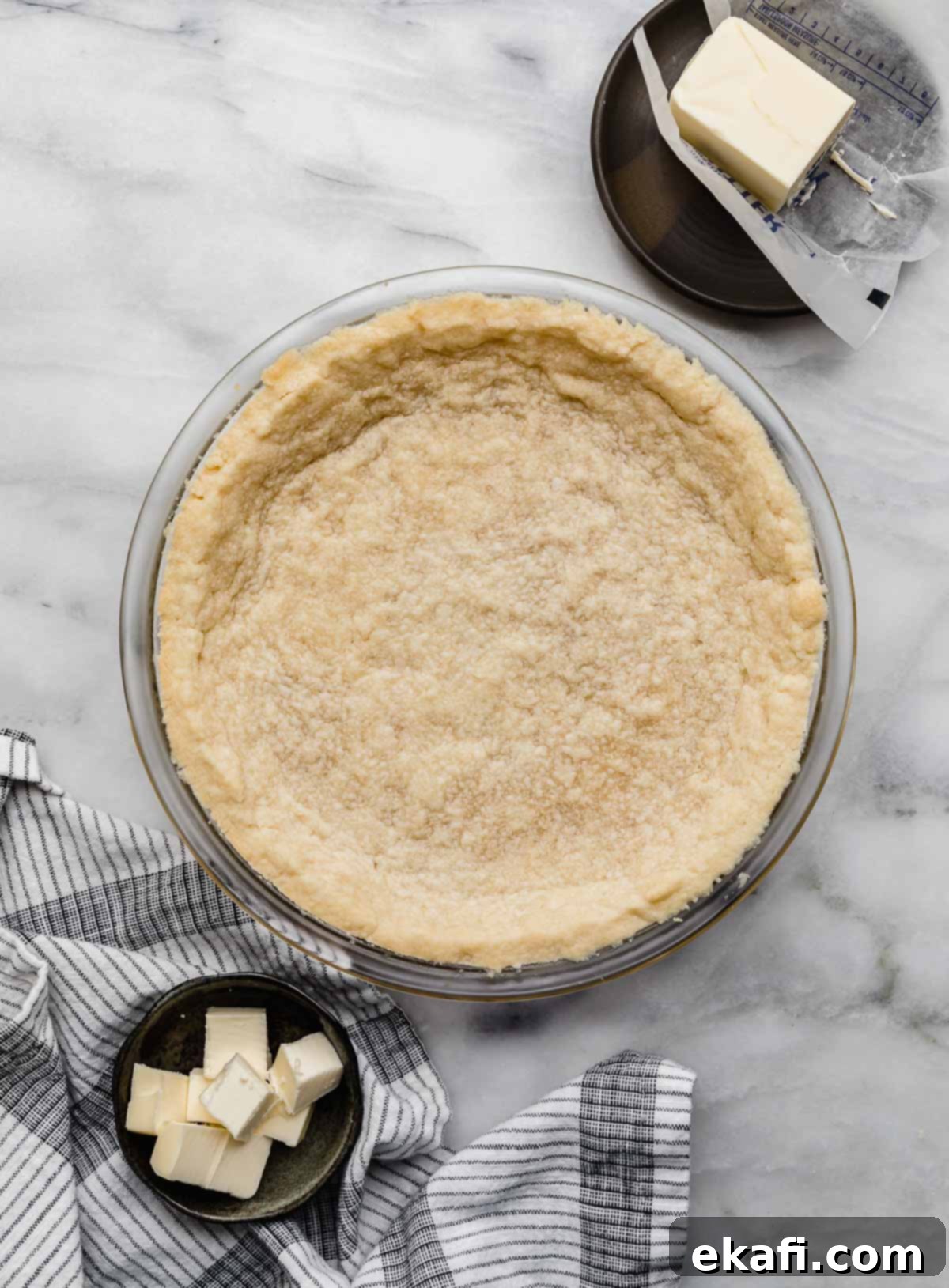The Ultimate Easy Shortbread Pie Crust Recipe: Buttery Perfection for Any Pie
Tired of wrestling with traditional pie dough? This incredible shortbread pie crust offers a delightful, stress-free alternative that promises a beautifully buttery, lightly sweet, and perfectly crumbly base for all your favorite pies. Forget complex rolling and chilling steps; this is an easy, press-in crust designed for convenience without compromising on flavor or texture. Its rich, cookie-like foundation elevates any pie, making it a go-to recipe for both novice and experienced bakers seeking a fuss-free yet sophisticated homemade touch.
The versatility of this shortbread pie crust is truly its superpower. While it perfectly complements creamy, tangy fillings like our beloved Lemon Sour Cream Pie, its subtle sweetness makes it an ideal partner for a vast array of pie types. Imagine the warm, comforting notes of a classic Pecan Pie or the seasonal spice of a Pumpkin Pie, all cradled in this tender, buttery shell. It’s robust enough to stand up to baked fillings yet delicate enough to enhance no-bake delights such as the decadent French Silk Pie or the refreshing Peach Cream Pie. The possibilities are truly endless, limited only by your imagination!
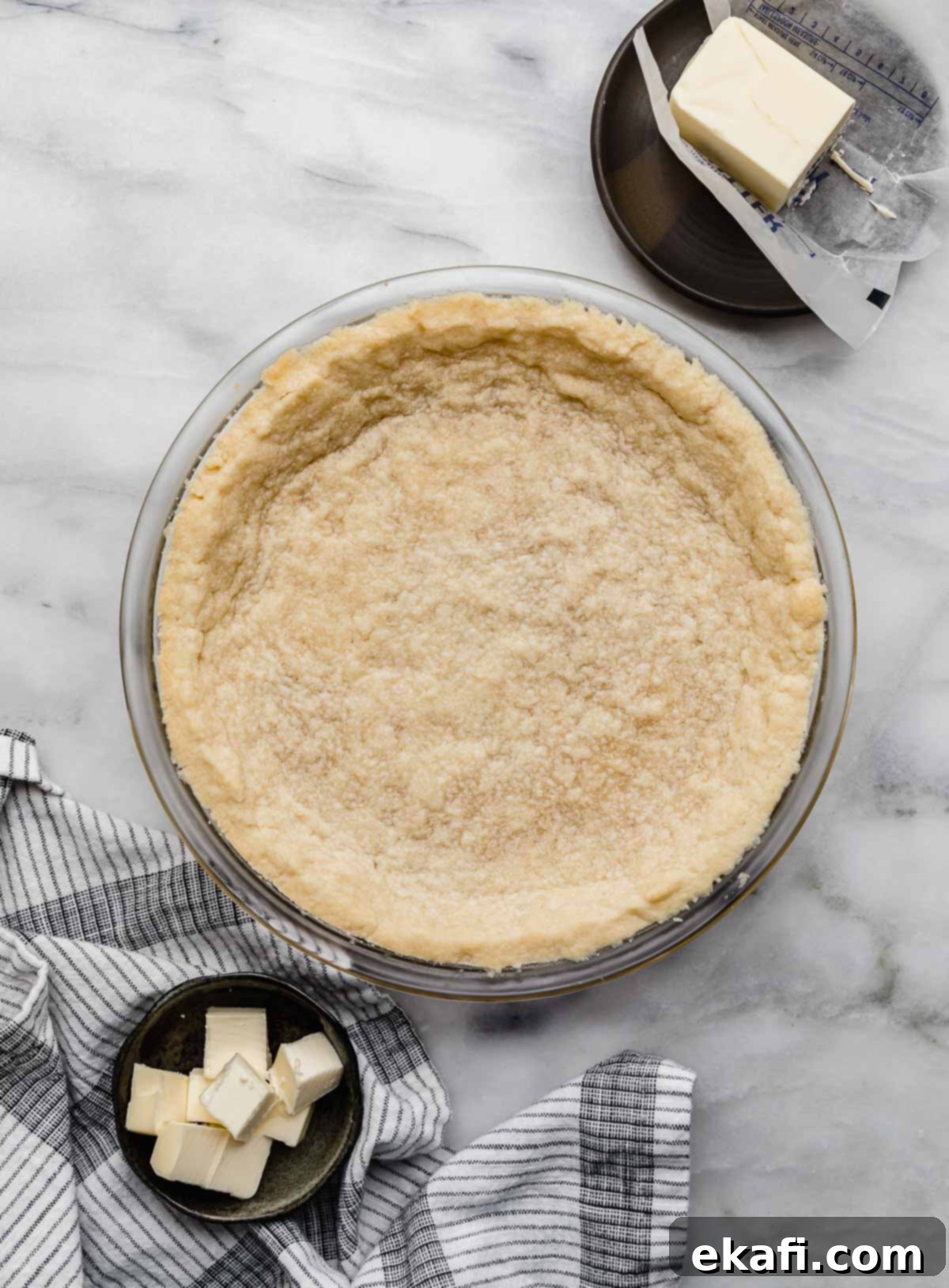
Why This Easy Shortbread Pie Crust Recipe Will Be Your New Favorite
- A Dreamy 4-Ingredient Pie Crust: Baking a homemade pie crust can often feel like a culinary challenge, requiring precision and patience. However, this shortbread crust recipe is designed to be incredibly approachable, simplifying the process without sacrificing quality. With just four common ingredients – butter, flour, powdered sugar, and a touch of salt – you likely already have everything you need in your pantry. This minimalist ingredient list means less shopping, less fuss, and more time to enjoy your delicious creation. It’s the ultimate solution for anyone intimidated by traditional pie dough, offering a quick and satisfying path to a homemade pie.
- Effortless Press-In Method for a Buttery Crust: One of the standout features of this shortbread pie crust is its remarkably simple preparation method. Unlike conventional pie crusts that demand careful handling, precise rolling, and strict temperature control for the butter, this recipe is a pure press-in wonder. There’s no need for special equipment like a pastry blender or food processor to achieve perfect results. You simply mix the ingredients until they form a crumbly dough, then use your hands to press it firmly and evenly into your pie dish. This hands-on approach is not only therapeutic but also ensures a perfectly textured crust every time. A brief chill and a quick bake are all that stand between you and a golden, buttery pie base, making it incredibly time-efficient.
- Perfect Texture and Flavor: This shortbread crust boasts a delightful crumbly yet tender texture, thanks to its high butter content, which inhibits gluten development. It’s sweet enough to complement fruity and creamy fillings but not so sweet that it overpowers them. The rich, buttery flavor is the star, making it a fantastic alternative to a standard pastry crust for a more cookie-like experience.
Key Ingredients for the Perfect Shortbread Pie Crust
Creating an exceptional shortbread pie crust relies on a few simple, high-quality ingredients. Each plays a crucial role in achieving that signature buttery flavor and tender, crumbly texture. Understanding their purpose will help you master this easy recipe.
- Unsalted Butter: As the name “shortbread” suggests, butter is the hero of this recipe, providing its iconic rich flavor and melt-in-your-mouth texture. We use a generous amount, which is characteristic of shortbread, as the high fat content works to inhibit gluten formation in the flour. This results in a deliciously tender and crumbly crust that practically dissolves on your tongue, rather than being chewy or tough. Using unsalted butter is recommended because it gives you precise control over the salt content in your recipe, allowing you to perfectly balance the flavors. Ensure your butter is at room temperature to cream easily and blend smoothly with the other ingredients.
- All-Purpose Flour: This forms the structural foundation of our shortbread dough. While butter contributes to the tenderness, flour provides the necessary body to hold the crust together. All-purpose flour is ideal for its balanced protein content, which allows for just enough structure without making the crust tough, especially when combined with the high butter ratio that limits gluten development.
- Powdered Sugar: While granulated sugar is traditional for some shortbread recipes, powdered sugar (also known as confectioner’s sugar) is our secret weapon for a truly superior pie crust. Its fine texture blends seamlessly into the dough, resulting in a smoother, more uniform consistency and a tender bite. Furthermore, powdered sugar imparts a delicate sweetness that enhances rather than overwhelms your pie filling. Shortbread is known for being only lightly sweet, which makes it an excellent choice for pairing with a wide range of sweet and tart pie fillings, creating a harmonious flavor profile.
- Salt: A mere ½ teaspoon of salt might seem small, but it’s a mighty ingredient! Salt doesn’t just add flavor; it balances the sweetness of the sugar and truly enhances the rich, buttery notes of the shortbread. It brings all the flavors into harmony, ensuring your pie crust isn’t just sweet, but deliciously well-rounded and irresistible. Without it, the crust would taste flat.
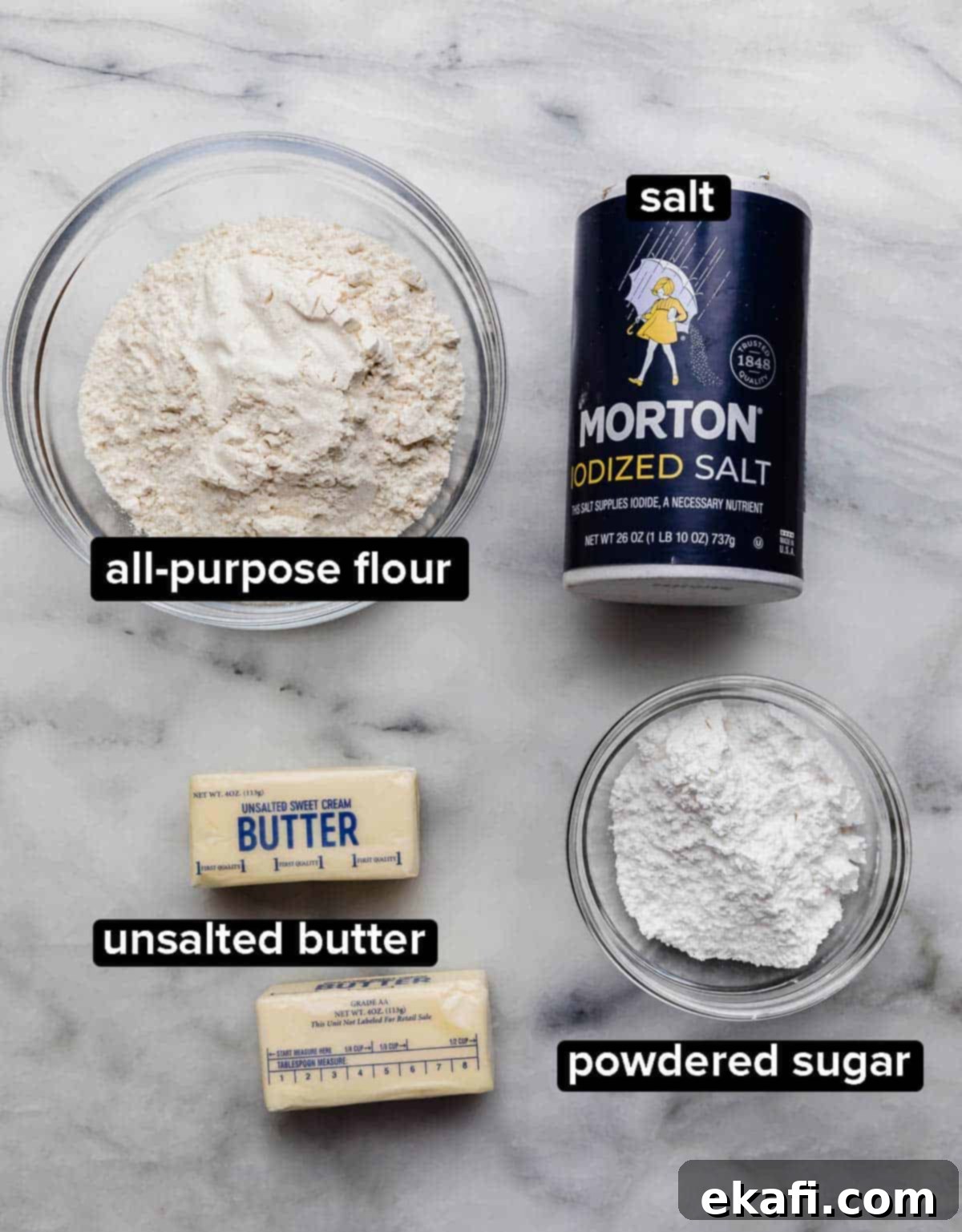
Step-by-Step Guide: How to Make Shortbread Pie Crust
Making this buttery shortbread pie crust is incredibly straightforward, even for beginner bakers. Follow these simple steps to create a perfect foundation for your next pie.
- Prepare Your Pie Dish: Begin by lightly spraying the bottom of a 9-inch pie plate with a nonstick cooking spray. This crucial step ensures that your delicious shortbread crust will release easily from the pan once baked. While a standard 9-inch pie plate is ideal, you can also use a tart pan for a slightly different presentation or even an 8-inch pie pan if you prefer a thicker crust.
- Cream the Butter: In a large mixing bowl, add 1 cup (equivalent to 2 sticks or 16 tablespoons) of unsalted butter that has been softened to room temperature. Using a hand mixer or stand mixer, beat the butter until it’s light, fluffy, and smooth. This creaming process incorporates air into the butter, contributing to the crust’s tender texture.
- Incorporate Dry Ingredients: To the creamed butter, gradually add 2 cups of all-purpose flour, ½ cup of powdered sugar, and ½ teaspoon of salt. Mix on low speed until all the ingredients are just combined and a soft, crumbly dough begins to form. Be careful not to overmix, as this can develop the gluten in the flour and result in a tougher crust. The dough will look crumbly, almost like wet sand, but it should hold together when pressed.
- Press Dough into Pan and Chill: Transfer the crumbly shortbread dough into your prepared pie dish. Using your clean hands, firmly and evenly press the dough into the bottom and up the sides of the pan. Pay attention to creating a uniform thickness for even baking. Once pressed, refrigerate the shortbread crust for 20-25 minutes, or, if you’re in a hurry, chill it in the freezer for about 15 minutes. This chilling step is essential as it firms up the butter, which helps prevent the crust from shrinking during baking and ensures a crispier texture.
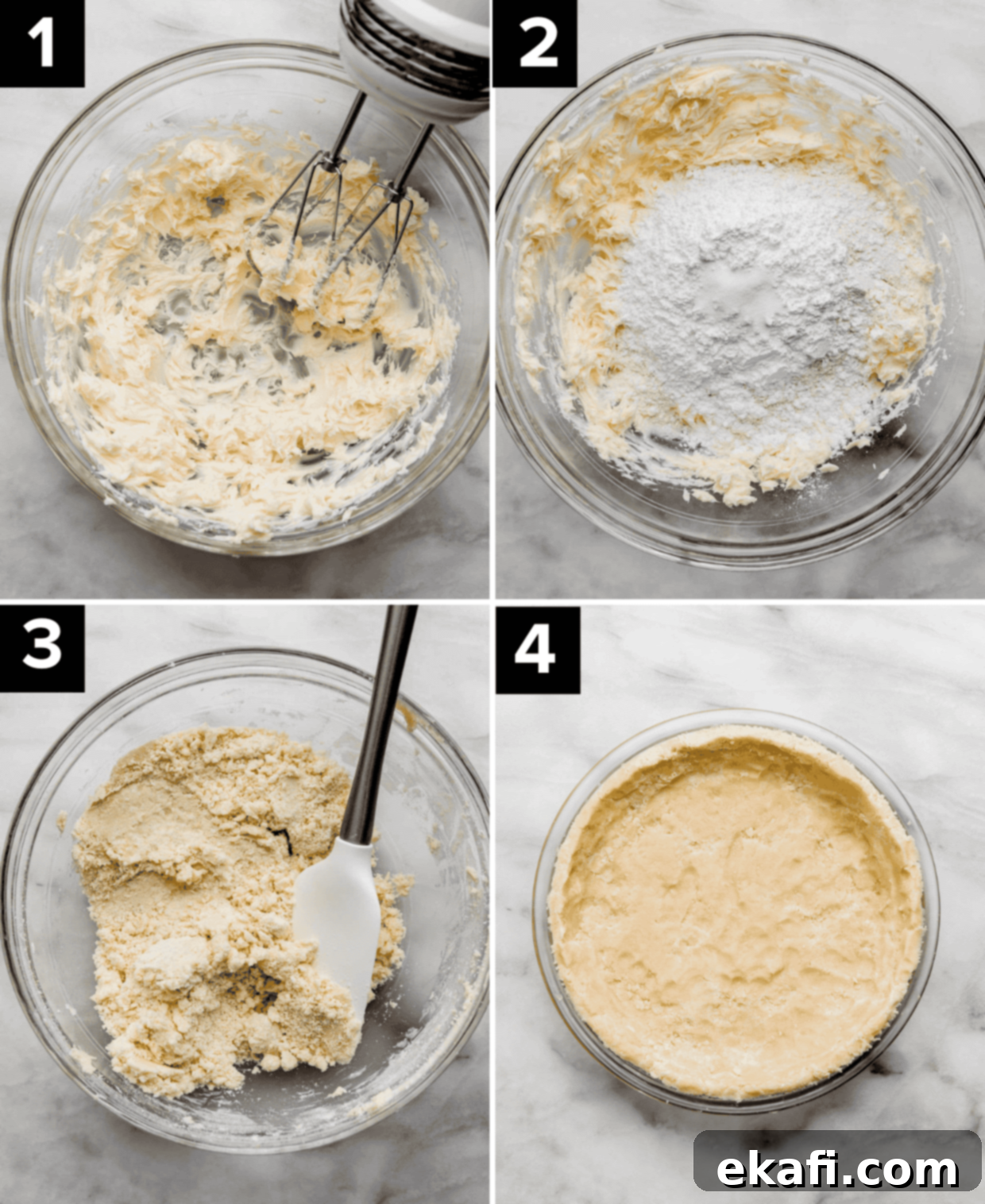
- Preheat Your Oven: While your shortbread cookie crust is chilling in the fridge or freezer, preheat your oven to 350°F (175°C). This ensures the oven is at the correct temperature when the crust goes in, promoting even baking.
- Bake the Shortbread Crust: Once sufficiently chilled, carefully place the pie dish with the crust into the preheated oven. Bake for 15-20 minutes, or until the edges are lightly golden and the center appears set and slightly pale. It’s important not to overbake; shortbread should maintain a delicate, pale color, not a deep brown, to preserve its tender, crumbly texture. After baking, remove the crust from the oven and allow it to cool completely on a wire rack before adding any pie filling. Cooling completely prevents your filling from melting or becoming soggy.
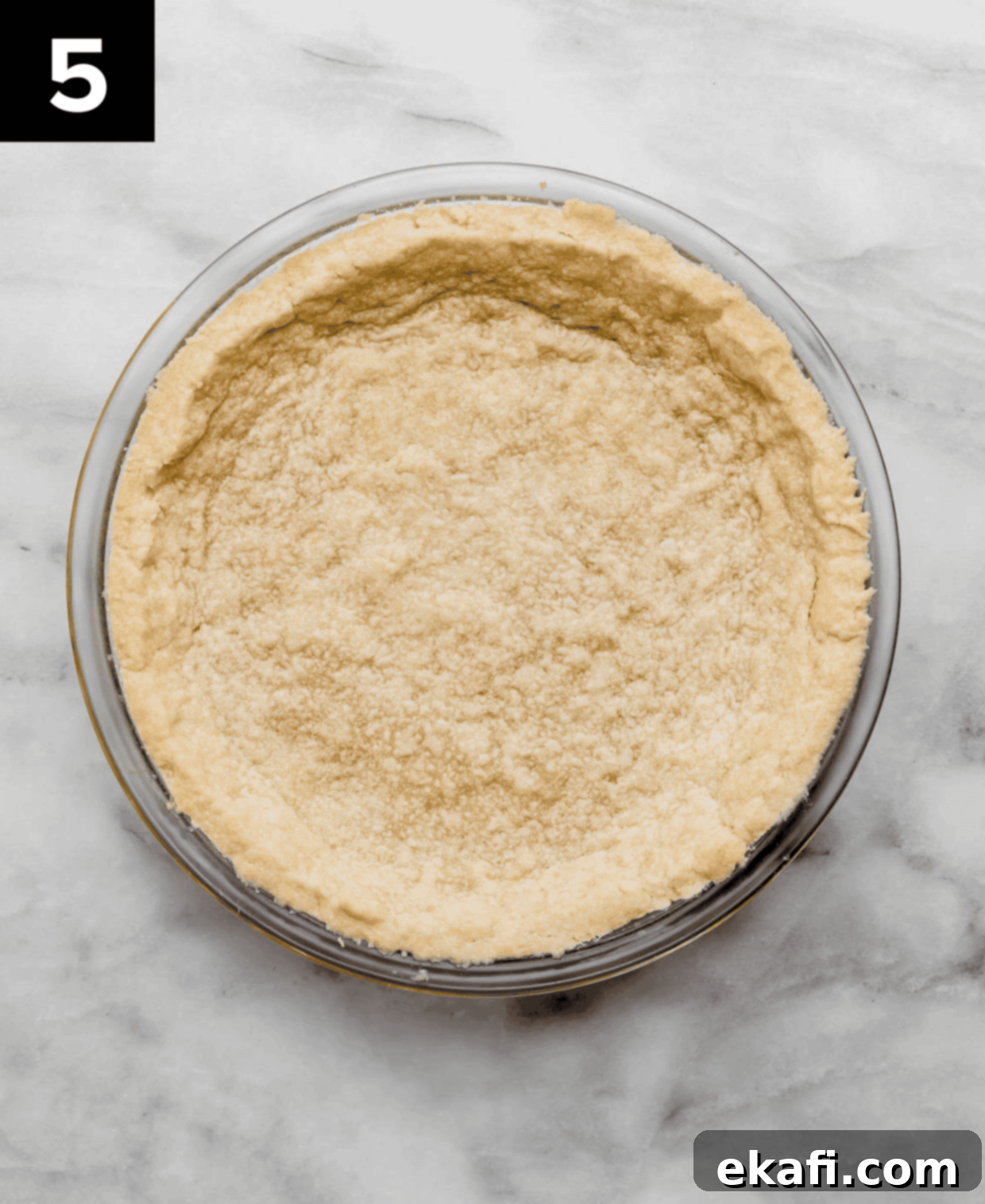
Expert Tips for a Flawless Shortbread Pie Crust
Achieving a perfect shortbread pie crust is simple, but a few expert tips can elevate your results from good to absolutely outstanding. Here’s how to ensure your crust is always tender, buttery, and delicious:
- Adjusting for Salted Butter: If you find yourself without unsalted butter, don’t fret! You can absolutely use salted butter, but remember to adjust the additional salt in the recipe to maintain the perfect flavor balance. Reduce the added salt to ¼ teaspoon, or omit it entirely, depending on how salty your butter is and your personal preference.
- Pan Size Flexibility: While a 9-inch pie pan is a standard choice, this versatile shortbread dough adapts beautifully to other pans. A tart pan works wonderfully for a more elegant presentation. If you use a smaller 8-inch pie pan, your crust will simply be a bit thicker, offering a heartier bite, which can be delightful with certain fillings. Just ensure even pressing for consistent results.
- Mind the Color – Don’t Overbake!: This is a crucial tip for shortbread. Unlike some pastry crusts that aim for a deep golden brown, shortbread should remain relatively pale. If the crust gets too dark, it will become dry and crispy, losing its signature tender and crumbly texture. Keep a close eye on it during the last few minutes of baking; a lightly golden edge is all you need.
- Protecting Edges for Baked Fillings: If you plan to use this pie crust for a filling that requires further baking (like a pumpkin or pecan pie), it’s wise to protect the edges of your pre-baked crust. Simply wrap a strip of aluminum foil around the exposed top part of the crust that isn’t covered by the filling. This prevents the edges from over-browning or burning during the second bake, ensuring your entire pie is perfectly cooked.
- Customizing Flavors: One of the joys of baking is personalization! Feel free to experiment with flavor variations to perfectly complement your chosen pie filling. A few drops of almond extract can add a delightful nutty aroma, while a teaspoon of pure vanilla extract enhances nearly any dessert. For a zesty lift, incorporate fresh orange or lemon zest into the dough. Spices like a pinch of cinnamon or nutmeg could also add a warm, inviting note, especially for fall-themed pies. These additions can transform your simple shortbread crust into a truly unique and memorable component of your pie.
Make Ahead, Storing, and Freezing Your Shortbread Pie Crust
Preparing components in advance can significantly simplify your baking process. This shortbread pie crust is wonderfully accommodating when it comes to make-ahead, storage, and freezing options.
- Make Ahead: This pie crust is perfect for meal prepping your desserts! You can bake the crust up to two days in advance, allowing it to cool completely before storing. This flexibility helps to drastically cut down on day-of preparation time for your pies, making entertaining or holiday baking much less stressful. Once your pie is assembled with its filling, its freshness will depend on the filling itself, typically staying good for 2-3 days, either at room temperature (for certain pies) or, more commonly, in the refrigerator.
- Storing Baked Crust: To store a baked, unfilled shortbread pie crust, simply let it cool completely. Then, you can cover it loosely with plastic wrap or aluminum foil and leave it at room temperature for up to two days. If you’ve already filled your pie, follow the specific storage instructions for your pie filling to ensure maximum freshness and safety, which often means refrigeration.
- Freezing Baked Crust: For longer storage, a baked shortbread pie crust freezes beautifully. Once the crust has cooled completely, carefully double wrap it first in plastic wrap and then in aluminum foil. This double layer of protection helps prevent freezer burn and keeps out any odors. It will remain fresh and delicious in the freezer for up to 2 months. When you’re ready to use it, simply thaw the crust in the refrigerator overnight before adding your desired filling.
- Freezing Raw Dough: You can also prepare the shortbread dough in advance and freeze it unbaked. After mixing the dough but before pressing it into a pan, wrap the dough tightly in plastic wrap or place it in an airtight, freezer-safe container. It will keep well in the freezer for up to 2 months. To use, transfer the frozen dough to the refrigerator and allow it to thaw completely before pressing it into your pie dish and proceeding with the baking steps.
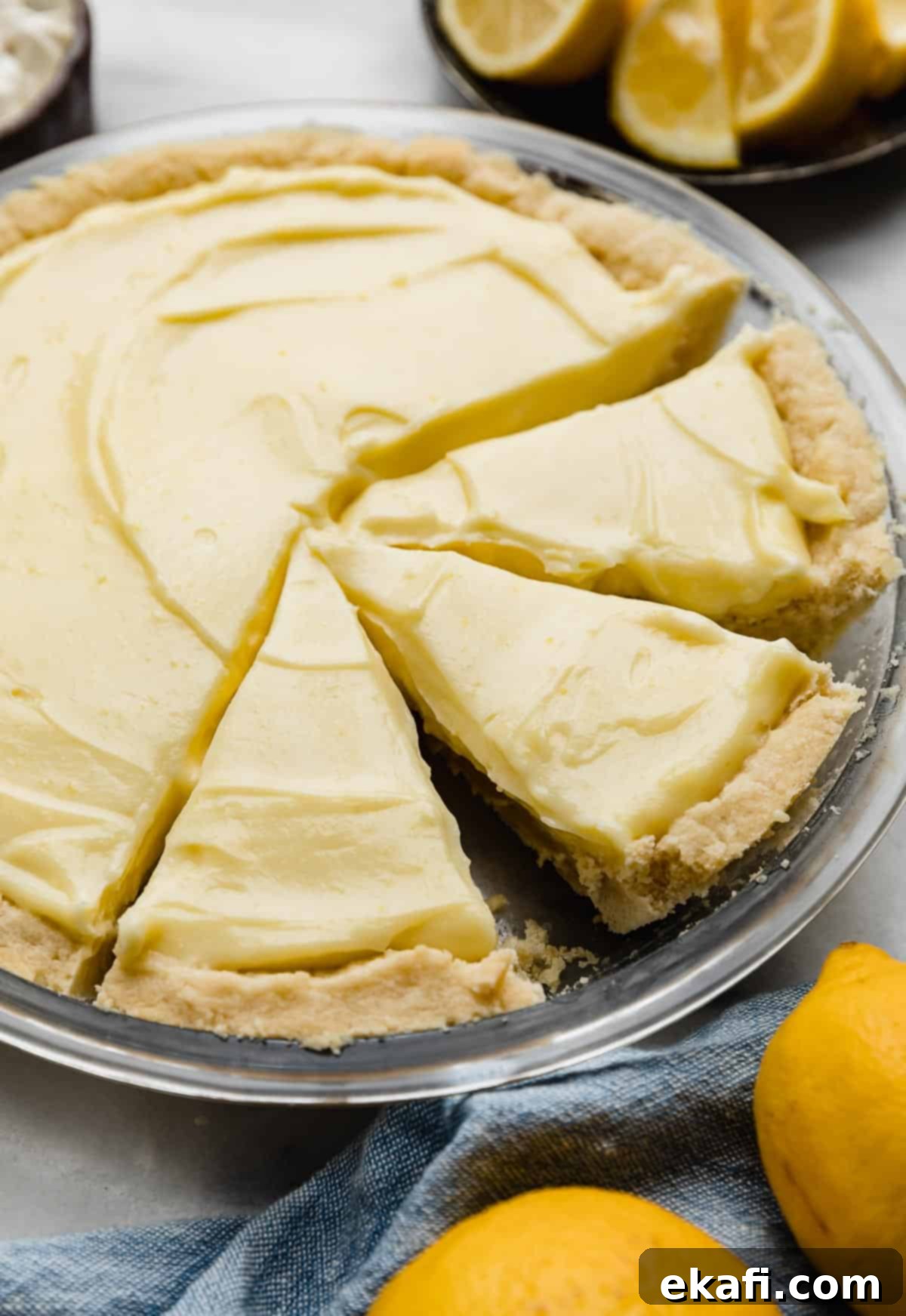
Frequently Asked Questions About Shortbread Pie Crust
The beauty of a shortbread pie crust lies in its incredible versatility! It pairs wonderfully with nearly any pie filling you can imagine. Its buttery, lightly sweet, and crumbly texture provides a delightful contrast and complements both sweet and tart flavors. Think rich, creamy pies like Key Lime Pie, custardy favorites, or even decadent Brownie Pie. It’s also fantastic for fruit pies, balancing their natural sweetness or tartness with its rich base. Don’t hesitate to experiment with your favorite recipes!
Absolutely! A shortbread crust is a fantastic, flavorful alternative to traditional pastry for pumpkin pie. To use it, simply bake the shortbread crust as directed in this recipe until it’s lightly golden and cooled. Then, pour in your prepared pumpkin pie filling and bake the entire pie according to your pumpkin pie recipe’s instructions. Remember to protect the exposed edges of the shortbread crust with aluminum foil if the filling doesn’t reach the top to prevent them from over-browning during the second bake.
Shortbread is naturally crumbly due to its high butter content and minimal gluten development, which is exactly what gives it its tender, melt-in-your-mouth quality. However, if your shortbread pie crust is excessively crumbly and falls apart easily, there could be a few reasons. The most common culprit is overbaking. Shortbread should only be baked until it’s lightly golden at the edges and still looks pale in the center; a deep brown color indicates it’s overdone and will likely be dry and overly crisp, leading to excessive crumbling. Another factor could be too little moisture (though less common with this recipe’s butter ratio) or improper mixing. Ensure you mix until just combined and press firmly into the pan to help it hold its shape.
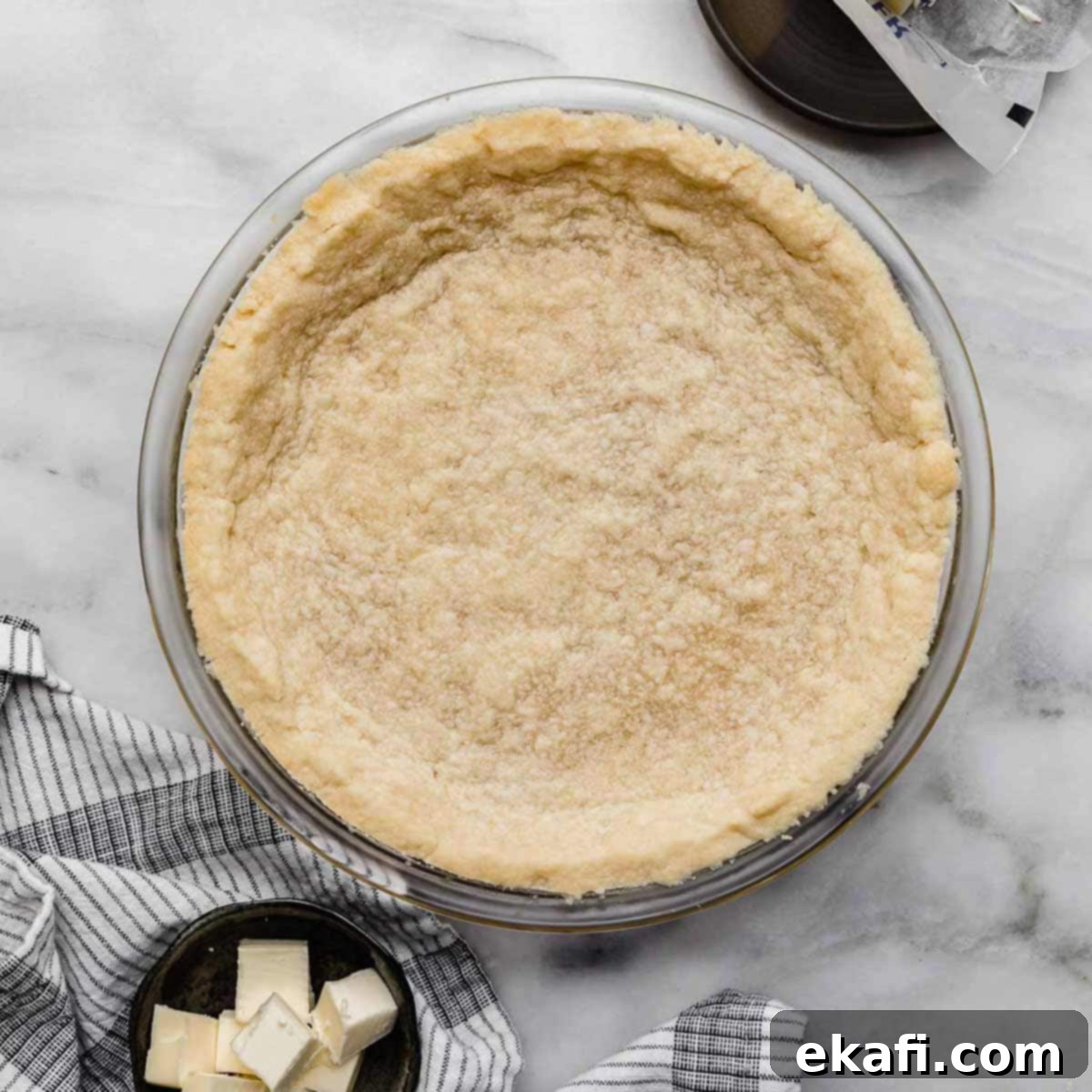
Explore More Delicious Pie Crust Recipes
While this shortbread pie crust is a fantastic choice, sometimes you might want to try something different! Expand your baking repertoire with these other tried-and-true pie crust recipes, each offering a unique flavor and texture profile for your favorite desserts.
- Food Processor Pie Crust
- Oreo Pie Crust
- Graham Cracker Crust
- Biscoff Crust
Did you make this recipe? I’d love to hear about it! Please leave a star rating and review or scroll below the recipe card and do so there.
Stay up-to-date by following us on Instagram, TikTok, YouTube, Facebook, and Pinterest.
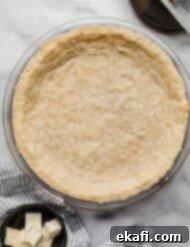
Print
SaveSaved!
Review
Shortbread Pie Crust Recipe
Ingredients
- 1 cup unsalted butter – softened to room temperature
- 2 cups all-purpose flour
- 1/2 cup powdered sugar
- 1/2 teaspoon salt
Instructions
-
Spray the bottom of a 9″ pie plate or tart pan with nonstick cooking spray to ensure easy release.
-
In a large mixing bowl, cream the room-temperature butter with a mixer until it’s smooth and fluffy. Add the all-purpose flour, powdered sugar, and salt to the bowl. Mix on low speed until all ingredients are just combined and a soft, crumbly dough forms. Be careful not to overmix the dough. Using your clean hands, firmly press this crumbly dough evenly into the bottom and up the sides of your prepared 9” pie plate or tart pan.
-
Chill the pressed shortbread crust in the refrigerator for 20-25 minutes, or for a quicker chill, place it in the freezer for 15 minutes. This step helps the butter set and prevents shrinking during baking.
-
While the crust is chilling, preheat your oven to 350°F (175°C).
-
Remove the crust from the fridge or freezer and bake for 15-20 minutes, or until the edges are lightly golden and the center is set and pale. It’s important not to overbake for the best crumbly texture. Allow the crust to cool completely on a wire rack before adding your desired pie filling.
Notes
If your pie filling requires further baking, cover the exposed edges of the shortbread crust with aluminum foil. This prevents them from over-browning or burning while the pie bakes.
Nutrition
